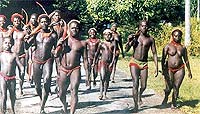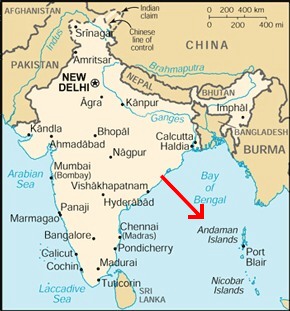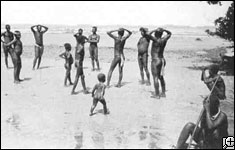 Reproduced for Fair Use Only
Reproduced for Fair Use Only
Picture Copyright © IndiaTimes.comMore photos hereAndaman anger at aid 'failures'New arrivals in Port Blair say people elsewhere are starving
Tsunami survivors in India's Andaman Islands have accused the authorities of underplaying the extent of devastation and failing to hand out aid.
Frustration boiled over in the town of Campbell Bay when a crowd demanding food and water assaulted an official.
A disaster management committee is meeting in the capital, Port Blair, to assess the relief effort.
Nearly 9,000 people are known to have died across India, 700 of them in the islands, with thousands more missing.
Full Article - bbc.co.ukConstant fear haunts Andaman tourists The several aftershocks that have been rocking Andaman and Nicobar Islands since last Sunday's earthquake have instilled a sense of mortal fear in the people, especially tourists, in Port Blair.
Full Article - ndtv.com
As many as 656 Nicoborese aborigines in the worst-affected Nicobar Islands are dead and about 3,000 belonging to the tribe are missing five days after the tsunami hit the southern coastline of the country.
Official figures put the population of Nicoborese at 28,653 as per the 2001 census.
Government would be sending teams to areas where the aborigines -- Andamanese, Onges, Jarawas, Sentinelese, Shompens and Nicoborese -- live to make a factual assessment of their present status, a senior Home Ministry official today said.
According to official figures, 49 Andamanese living in Strait Islands were safe while 94 Onges in Little Andaman's have been surveyed by a helicopter and were safe.
full story Reproduced for Fair Use Only
Reproduced for Fair Use Only
Picture Copyright © The Andaman AssociationMore about the Andaman people
Early Africa to Asia Route Mapped
 By Jennifer Viegas, Discovery News
By Jennifer Viegas, Discovery NewsEarly humans approximately 100,000 years ago traveled from Africa to Asia via a southern route that likely passed along the coasts of what are now Pakistan and India, according to researchers at Oxford University.
The finding helps to explain how humans began to settle in Asia, and why certain isolated populations throughout Southern Asia share a common history and possess similar genes.
Researchers were able to map the migration route after identifying a genetic marker in samples of inaccessible populations from the Andaman Islands in the Bay of Bengal. The samples were provided by the Natural History Museum of London.
A paper detailing the study is published in the current issue of the American Journal of Human Genetics.
Andaman Islanders, who live as hunter-gatherers, largely remain isolated from the developed world. Since the earliest days of Victorian anthropology they have fascinated scholars by their distinctive appearance. They possess very dark skin, tight curly hair and are short in stature compared to other groups in the region.
Because of their ancient way of life, remote location and distinctive physical appearance, scientists have speculated that the Andaman people represent the original inhabitants of the area, possibly those who left Africa between 53,000-93,000 years ago.
Phillip Endicott, a researcher in the Henry Wellcome Ancient Biomolecules Center of Molecular Evolution at Oxford University's Department of Zoology, and his colleagues discovered that the Andaman people possess a certain kind of DNA found in their cellular mitochondria. This haplogroup, or lineage, appears to be a subgroup, called M2, of a genetic marker linking many Asian people: M.
The presence of M2 could explain why some people in southern Asia share similar characteristics.
"There are many similarities between groups of hunter-gatherers within India and Southeast Asia," Endicott told Discovery News. "Our paper shows that there is on average a 23 percent occurrence of M2 within these groups in India."
Travel, intermingling with other cultures and recent population changes could explain why M2 is not present in all Asians. The closeness of the M and M2 groups, however, does provide a genetic link.
"The findings suggest that the similarities between these now isolated populations of Asia are not coincidental and that these peoples really do share a common history," commented Chris Stringer, a professor at the Natural History Museum in London.
Stringer added, "The presence of M2 in significant proportions amongst the more European-looking caste populations of India indicates that many of these early settlers were absorbed into later population expansions."
Endicott and his team, through the "Indian Rim Project" funded by the National Environment Research Council, hope to further determine how early humans evolved and migrated from Africa to Asia.
http://dsc.discovery.com/news/briefs/20030203/andaman.htmReproduced for Fair Use Only
Picture(s): Courtesy of The Andaman Organization
Copyright © 2002 Discovery Communications Inc.


 Home
Home

 Help
Help

 Search
Search

 Login
Login

 Pages: 1
Pages: 1
 Pages: 1
Pages: 1






